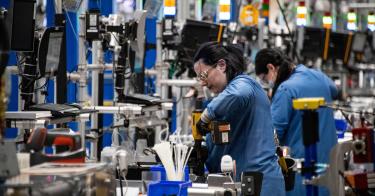Economist Milton Friedman’s maxim that “nothing is so permanent as a temporary government program” applies to work visas that are supposed to be temporary.
Every week brings a new headline about layoffs in the tech sector amid falling share prices, rising inflation, and the end of cheap money. Still, the decreasing demand for labor doesn’t seem to be reducing the demand for foreign tech workers.
Among Big Tech companies, Amazon cut 18,000 employees, Google 12,000, Microsoft 10,000, Meta (Facebook) 11,000, Salesforce 8,000, Twitter 4,000 (half the company), IBM 3,900, and Yahoo 1,600 (or 20% of staff).
Smaller companies where layoffs represent higher percentages of the workforce are downsizing too. Spotify cut 600 employees or 6%, Snap laid off 1,000 or 20%, Robinhood cut 25%, and Zoom cut 15%.
A website tracking tech industry redundancies reports that 1,046 companies laid off more than 161,061 employees in 2022; so far in 2023, 403 companies have let go over 110,720.
Among those losing jobs in the tech sector are likely “tens of thousands” of H-1B visa holders, according to The Wall Street Journal, which adds that foreign-born workers “account for nearly one-quarter of all workers in the STEM fields.”
Under U.S. immigration law, H-1B visas may be awarded to aliens who are “coming temporarily” to America to work in a “specialty occupation.” In practice, this means foreign workers with a bachelor’s degree, most often in the sciences.
Amazon, Google, IBM, Microsoft, Facebook, and Apple are all among the top 15 employers of workers with H-1B visas. Yet despite the layoffs, it’s business as usual at U.S. Citizenship and Immigration Services.
“For FY 2023, we received 483,927 H-1B registrations and selected 127,600 registrations projected as needed to reach the FY 2023 numerical allocations,” the agency says on its website.
The demand for such visas is so high that Citizenship and Immigration Services will open initial registration for H-1B visas during fiscal year 2024 for only two weeks in March before agency officials expect all the slots to be taken.
Something doesn’t quite add up.
Officials created H-1B visas in 1990 to supplement skilled American labor when demand exceeds supply by granting guest-worker visas that are good for three years.
The process requires certification by the Labor Department that no qualified American is available to hire. However, since the program’s inception, H-1B visas also have been criticized as a source of cheap labor that is detrimental to American workers. These guest-worker visas often are treated by both applicants and employers as a virtual immigrant visa.
Pressured by employers and lobbyists, Congress has expanded both the annual cap and time limits for H-1B visas.
H-1Bs originally were limited to 65,000 a year, but in 2000, Congress exempted from the cap all “workers who are petitioned for or employed at an institution of higher education or its affiliated or related nonprofit entities, a nonprofit research organization, or a government research organization.”
Then, in 2005, Congress added 20,000 H-1Bs a year for applicants with a master’s degree or more from a U.S. school. In 2019, over 600,000 H-1B workers and family members were admitted to the U.S.
Over time, the original three-year limit has been extended to seven years, and other exceptions have been added. Now, in practice, almost anyone who has an application for permanent U.S. residency in the processing pipeline can stay and keep working indefinitely.
Indians, who make up the bulk of H-1B recipients, often wait years because legal caps limit the number of immigrant visas each country can get each year. The wait is so long that some of their grown-up children now are lobbying to be allowed to stay—although, remember, the parents came on a temporary “nonimmigrant” visa.
“Nearly 80,000 Indian IT professionals on H-1B and L1 [intra-company transfer] visas [are] now jobless scrambling for options to stay in the U.S.,” New Delhi-based news site Mint reported.
Luckily for these professionals, Mint reported, the Foundation for India and Indian Diaspora Studies “launched a community-wide effort to try [to] help these IT professionals by connecting job seekers to job referrers and informers.”
The foundation also will try “to influence policymakers and decision-makers” at Citizenship and Immigration Services, according to the report.
The Biden administration’s Department of Homeland Security, which includes USCIS, is bending over backward to help. USCIS’ ombudsman held a “listening session” Jan. 13 to dispense helpful advice that you’d normally have to pay an immigration lawyer to get. The event was called “Immigration Concerns and Options for Laid-Off Foreign Workers.”
Is the government providing advice to American tech workers on how to find a new job? Or how to get one of the supposed 129,000 urgent job vacancies in fiscal year 2024, which companies already are applying to fill with H-1B visas?
Temporary work visas such as the H-1B were intended to supply short-term labor while the U.S. market adjusted, not to be a migrant worker-to-immigrant program. So why is the H-1B still massively oversubscribed, 30 years after it was created? I’d argue that U.S. dependency on immigrant labor in high tech has two main causes.
The first is that public education is failing to produce the graduates that employers need. This starts in grades K-12, where the “nation’s report card” makes bleak reading. Math scores last year saw the biggest declines since 1990, and two-thirds of fourth graders can’t really read.
The already poor national average obscures some particularly bleak spots: At 53 schools in Illinois, not a single student is able to do basic math. That’s also true of 23 schools in Baltimore, Maryland. Only 21% of students in Chicago Public Schools tested at or above proficient in math.
In high schools and higher education, standardized tests and objective grades gradually are being eliminated in the name of “equity.” The more that competitive colleges lower standards both to enter and to graduate, the less they will produce workers able to compete with the world’s best.
On top of that, in 2020 only around 53,000 students received bachelor’s degrees in computer science in the U.S.—not even a quarter as many as in India—while nearly 40,000 Americans got sociology degrees.
U.S. industry also has gotten hooked on cheap foreign labor. Despite the clear intent of the visa program, and several regulatory attempts at controlling abuse, half of the top 30 companies employing H-1B visa holders in 2021 were outsourcers, mostly India-based.
These companies hire and farm out workers for U.S. companies, making it harder to determine whether the jobs they take are really available first to qualified American workers.
Washington Post columnist Heather Long predicts “a gradual slowing” of the economy in the near future. What you logically would see is reduced demand for foreign tech labor and the return home of thousands of H-1B visa holders to await the next boom.
But don’t bet on it.
This piece originally appeared in The Daily Signal




